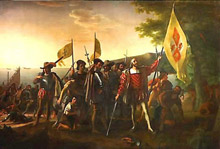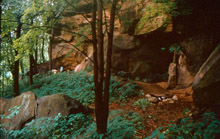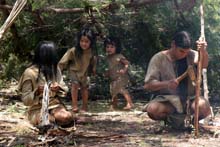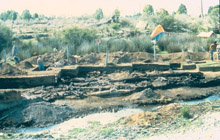
Christopher Columbus landing on San Salvador (or Samana Cay) and, essentially, sparking the debate about the initial colonization of the New World. Click image for larger view.
Evolving Beliefs
Revealing the Origin of North America’s Ancestors
J. M. Adovasio
C. Andrew Hemmings
On October 11, 1492, the soon-to-be styled Admiral of the Ocean Seas, Cristoforo Colon (a.k.a. Columbus), landed on San Salvador (or Samana Cay) and almost immediately encountered its aboriginal inhabitants, the soon-to-be extirpated Taino. Either he, or, more likely, members of his entourage posed a series of questions about these folk which, in one form or another, we have been asking ever since: First, who are these people? Second, where did they come from? Third, by what means did they get here? Fourth, and most vexatiously, when did they arrive?
A fifth question never posed by Columbus or his crew — but one which many scholars have since addressed — is: What were their early lifestyles like or, more simply, what were they doing?
Columbus, of course, thought he had the answers to most of these seminal queries. Convinced as he initially was that he had landed in the East Indies, the populations he encountered must therefore have been be Indians and were quickly so named. With the prevailing mindset of the time, these Indians were presumed to have been there since time immemorial; hence, issues of origins, mode of arrival, and timing of colonization were unimportant.
Columbus' Fallacies
When Vasco Nuñez de Balboa crossed the Isthmus of Panama and thereby demonstrated that this was, indeed, a New World unconnected to the Old, the fallacies of Columbus’ “answers” became readily apparent.

A view of Meadowcroft Rockshelter (facing west) just prior to the initiation of excavation. Click image for larger view.
Fast forwarding nearly four centuries, it would require a series of related developments in scholarly thought before more accurate answers to the questions posed by Columbus would be forthcoming. These included the birth of scientific geology, which provided the perspective of deep time not only for the age of the planet but also life upon it, specifically including humankind; the demonstration of the antiquity of humans in Europe and, by extension, other parts of the world; and ultimately, the realization (ironically posited as early as 1595) that the homeland of the ancestors of Native Americans was northeastern Asia.
By the beginning of the twentieth century, the received or conventional wisdom was that the first inhabitants of the New World had originated in nearby Siberia but had come quite recently in geological terms, arriving by boat no more than 6,000 to 8,000 years ago.
A "Bridge" Called Beringia
This temporal benchmark would only last two or three decades — until a series of discoveries in the American Southwest would conclusively demonstrate that the first colonists were contemporaries of late Ice Age animals and, therefore, had arrived here 10,000 to 12,000 years ago. At that time, Siberia was connected to Alaska by a dry land “bridge” that was exposed when sea levels dropped precipitously during the last Ice Age. This land connection, called Beringia (or the Bering Platform), would provide the venue by which early colonists walked here “dry shod,” with no need for boats.

This image portrays a reconstruction of Ice Age human behavior, with a focus on small familial groups and the processing and use of plants as opposed to athletically fit young men attacking large, dangerous animals. Click image for larger view.
By the mid-to-late 1960s, it was widely believed that the First Americans not only arrived here on foot from Siberia toward the end of the last Ice Age (ca. 12,000 years ago), but also that these intrepid pioneers were highly mobile, rapidly moving, specialized hunters. Their signature weapon was a lethal lance surmounted by a distinctive stone projectile point called Clovis, named after one of the localities of its recovery in the 1930s in New Mexico. These so-called Clovis hunters were thought to have spread very rapidly across the length and breadth of the New World, arriving at the tip of South America within 500 years of their initial entry. Because of the apparent and not infrequent co-occurrence of Clovis spear points with the bones of extinct animals — notably including mammoth, mastodon, bison and other Ice Age beasts — the makers of these points were believed to be responsible for the extinction of some 35 species of Ice Age animals.

Excavations at Monte Verde. In the foreground, along Chinchihuapi Creek, the excavators are uncovering residential structures. Click image for larger view.
The Clovis-first Myth
By the early 1970s this chronological and behavioral scenario called “Clovis first” was firmly established as virtual dogma within the North American archaeological community. The prevailing paradigm would begin to be questioned and, ultimately, unravel and collapse only after excavations at widely separated points in North and South America. This research at places like Meadowcroft Rockshelter in southwestern Pennsylvania and Monte Verde in Chile showed that humans had arrived before Clovis and that the lifestyle of these first Americans were very different from what previously had been imagined.
Instead of being specialized, spear-wielding big game hunters, some of the early colonists appeared, instead, to be generalized foragers who collected a wide array of small- to medium-sized animals heavily augmented by a diverse vegetal diet.
With the still ongoing demise and replacement of the Clovis first model, the excavation of and search for more pre-Clovis sites continues, both on land in so-called terrestrial settings and on now-submerged landscapes.
Sign up for the Ocean Explorer E-mail Update List.














